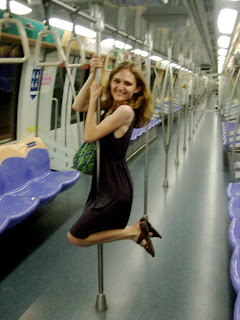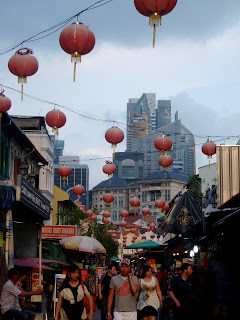I returned to a different hometown, free of blaring horns, fermenting garbage heaps, and beggars grasping for my shirttail. With poverty swept into the corner, Durham is quieter and cleaner than New Delhi. But now that I have left India, I miss the hum of the traffic, the swerve-or-die rules of the road, the constant bickering of rickshaw drivers. For despite the noise, and behind the dirt and grime, lies a city bursting with potential.
There is another side of New Delhi, one that makes side-by-side rickshaw conversations possible between traffic jams. One that brings the aroma of freshly cut marigolds right after the stench of rotting garbage. One that bonds me to a little boy as I press warm naan into his hungry hands. I miss the dichotomy of worlds New Delhi provides and the way the city forced me to confront the realities of hunger and poverty even as I enjoyed the wealth of beautiful music and the warmth of ceaseless hospitality.
I miss Singapore for the exact opposite reason. I miss the ease of hopping onto a metro with no stop more than thirty minutes away. I miss the street sweepers who brushed nothing but flower petals into their dustbins. I miss kiasu, which translates to “scared to fail” and was embodied in the harried metro travelers pushing their way onto a filled train.
I also miss the overt displays of modern architectural prowess: the towering Sands Hotel with rooftop Infinity Pool, the lotus-shaped museum, and the pineapple-esque Esplanade. “There are so many unique buildings, they loose their uniqueness,” one of my friends said as we stood on the Sands Hotel’s observation deck, overlooking the skyline. I understood his critique, yet I disagreed with his analysis. To me the superfluous number of unique buildings embodied the kiasu atmosphere which pervades the country and expresses the determination to be “the most cutting-edge.”
 |
| View of the Esplanade from the top of the Sands Hotel. |
But I left Asia with more than a love for city streets and a sense of architectural comparison. Throughout the trip, the Southeast Asia program (SEAS) class struggled with the meaning of identity. Some people made self-discoveries, but my journey took a different route. As a Global Studies major, I particularly enjoyed exploring the significance of identities extending beyond that of self to that of ethnicity and nationality. At the National University of Singapore (NUS), our professor, Dr. Quek Ser Hwee, called the fledgling Singaporean identity a “work in progress.”
I liked this description because it provided space for malleability and alteration. In a country bound by the Chinese-Malay-Indian-Other (CMIO) model, citizens are forced into boxes where they do not belong. Multi-racial children must choose their ethnicity, a policy which forces them to rank ethnic groups and pick the “best” one. Surely, the formation of Singaporean identity must be reshaped, for in a few years’ time the political incorrectness of such a model will be realized, and the entire foundation upon which it sits will be re-evaluated.
But I like the idea of a “work in progress” national identity for another reason as well: for just as individuals change, so too do nations. By definition “identity” is never rigid but rather pliable, for as the experiences of a nation change, so, too, does the country itself. Even as we learned about the history of Singapore, beginning with independence from Malaysia in 1965, we discussed current events such as the creation of more Housing and Development Board (HDB) flats and the recent parliamentary elections which took place this past May. And as we discussed the social implications of political decisions, I learned to view current events from a historical perspective and realized how closely the two are connected.
From an academic standpoint, we discussed identity as it pertained to ethnicity and nationality, but my time abroad expanded my ideas of identity far beyond this initial intellectual understanding. As we interacted with locals, I came to understand how the shells of ethnic and national identities influenced the individuals themselves. So, during my home stay in Singapore, I asked my host, Natalina Pereira, who is half-Indian and half-Chinese, how she felt about the CMIO model. She said that while she checks the Indian box on governmental forms, she does not identify with either group because neither accepts her as one of them. While her light complexion and choice to learn Mandarin make her appear more Chinese than Indian, her identity is further confused by other people’s reactions to her. She said her mixed race also influences her dating opportunities as Chinese men are not interested in dating non-Chinese women. Speaking with someone who is personally affected by the model helped me understand the consequences of such a system on the everyday lives of Singaporeans.
 |
| Natalina, Jessica, and I posing down the street from Ah Chew Desserts. during our home stay. |
Forty-six years removed from the split from Malaysia, the implications of independence still press on the minds of many Singaporeans, perhaps explaining the country’s kiasu atmosphere which affects everything from the rush of metro travels to the hyper-construction of modern architectural wonders. With recent history still playing such a significant role in the daily lives of Singaporeans and with current events quickly approaching the status of history, the events shaping the future direction of Singapore are anything but static, and the identity of its citizens is changing even as it is formed.
Currently, Singaporean identity is formed around a slew of catch-phrases which could be used to describe the country in a tour book: “multi-ethnic” and “multi-cultural” would be at the start of any list, quickly followed by “religiously tolerant.” For, just as the country is ethnically diverse, it also has a variety of religions which have been carried into the country by its immigrants. Thus, some Chinese follow Buddhist and Taoist traditions while the Malay are almost strictly Muslim, and Indians tend to follow Hinduism or Sikhism. Although these descriptions are fair, I would also add to the list of labels: “kiasu,” and, inspired by Dr. Quek’s words, an ellipses mark “…” to recognize future descriptions.
While India is home to a smaller range of ethnicities, its rich history and varied peoples also create a complicated national identity. When we arrived in India, we quickly realized that we could not blend with the locals. The color of our skin, no matter the shade, made us popular targets for family photographs, and we were asked to pose for pictures as often as we were persuaded to make bad bargains. While most of the people who live in India are Indians, the country is so large that regions create vast distinctions in culture, language, religion, and even skin color, although ethnicities are technically the same.
 |
| Posing for a picture with a young boy outside the Taj Mahal. |
With well over one billion people, the largest democracy in the world is home to thirty-three different languages and 2,000 dialects. Such a wide variety of languages provides space for different values and modes of thought. The broadest distinction in cultures can be made between the northern and the southern regions of India. We spent most of our time in New Delhi, but we still came across people who had immigrated to the Punjab from other parts of India, such as our dark-skinned rickshaw driver who came from the South and likened his skin tone to one of the African-American students in our group. In New Delhi we enjoyed copious amounts of naan and chapati dipped in thick, savory curries, but if we’d traveled to the South, our wheat-based diets would have been replaced by one composed mainly of rice.
Religion is another area of distinction in India, and with the superfluous numbers of temples and shrines, the prominence and significance of religion in India cannot be overlooked. While the majority of Indians ascribe to Hinduism, the country hosts a variety of religions including Islam, Christianity, Sikhism, Jainism, and Buddhism. Religion divides the country just as it unites believers within the separate groups. While we learned that the Sikhs try to overcome social and religious boundaries by offering free community lagars (meals), the evidence of unanswered hunger right outside Sikh temple gates speaks of invisible barriers which cannot even be overcome by a welcome invitation.
 |
| Enjoying a community lagar in India, around 3 p.m. |
With such vast distinctions, the formation of a single national identity is seemingly impossible. So, India and Singapore, apparent polar opposites, suffer from the same problem: an inability to unite under a common national identity. And I consider this similarity my greatest discovery, for drawing comparisons between countries provides valuable analysis, but finding commonalities between them has stitched my experiences together and has shrunk my world to a more handleable size.
My time abroad afforded me the opportunity to explore more than the effects of identity on society; it also allowed me to interact with that society. Upon my return to America, I have not spoken so much about my academic studies or even my observations about the inter-workings of identity on the individual and social psyche. Rather, I have talked animatedly about the people I met and the places we went together: hiking to the top of a rainforest canopy and spending the night in a Long House in Brunei, pulling NUS to victory during the Dragon Boat Festival and watching the sun set over the skyline atop the Sands Hotel during our final night in Singapore, and bargaining in the markets and visiting the Taj Mahal in India. These experiences have helped reshape my global perspective, and I anticipate my outlook to continue to change as I share my stories and reassess my experiences abroad. For perspective, like identity, is ever-evolving.




















































